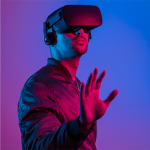What is Virtual Reality?
Virtual reality (VR) refers to a computer-generated simulation in which a person can interact within the 3-dimensional environment using head-mounted display (HMD) devices, such as Oculus, HTC Vive, Samsung gear, Lenovo, and other VR Device fitted with sensors. In this simulated artificial environment, the user is able to have a realistic-feeling experience.
The concept of virtual reality is built on the natural combination of two words: the virtual and the real. The former means “nearly” or “conceptually,” which leads to an experience that is near-reality through the use of technology. The software creates and serves up virtual worlds that are experienced by users who wear hardware devices such as goggles, headphones, and special gloves. Together, the user can view and interact with the virtual world as if from within.
- Virtual reality (VR) creates an immersive artificial world that can seem quite real, via the use of technology.
- Through a virtual reality viewer, users can look up, down, or any which way, as if they were actually there.
- Virtual reality has many use-cases, including entertainment and gaming, or acting as a sales, educational, or training tool.


To understand virtual reality, let’s draw a parallel with real-world observations. We understand our surroundings through our senses and the perception mechanisms of our body as well as spatial awareness and balance. The inputs gathered by these senses are processed by our brains to make interpretations of the objective environment around us. Virtual reality attempts to create an illusory environment that can be presented to our senses with artificial information, making our minds believe it is (almost) a reality.

